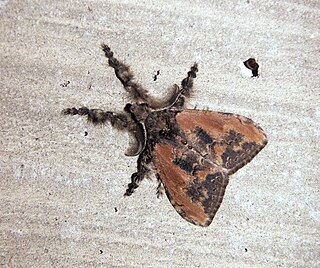
Olene mendosa, the brown tussock moth or hairy tussock moth, is a moth of the family Erebidae. The species was first described by Jacob Hübner in 1823. It is found in India, Bangladesh, Sri Lanka, Indonesia, Taiwan, Thailand and Australia.

Anacamptodes fragilaria, the kiawe moth, koa haole looper or citrus looper, is a species of moth in the family Geometridae. The species was first described by John Arthur Grossbeck in 1909. It is found in the Hawaiian islands of Kauai, Niihau, Oahu, Molokai, Maui and Hawaii as well as California, where it is native.

Ectomyelois ceratoniae, the locust bean moth, more ambiguously known as "carob moth", is a moth of the family Pyralidae. It has a nearly cosmopolitan distribution.

Cryptophlebia illepida is a species of moth in the family Tortricidae that is endemic to the islands of Kauaʻi, Oʻahu, Molokaʻi, Maui, Lānaʻi and Hawaiʻi. Common names include koa seedworm, klu tortricid, koa seed moth, litchi borer, litchi moth, macadamia nut borer and macadamia nut moth. It was first described by Arthur Gardiner Butler in 1882.

Herpetogramma licarsisalis, commonly known as the grass webworm or pale sod-webworm, is a species of moth in the family Crambidae.
Adoxophyes privatana, the appleleaf-curling moth, is a moth of the family Tortricidae. The species was first described by Francis Walker in 1863. It is native to south-east Asia, where it has been recorded from Taiwan, Hong Kong, Hainan in China, Nepal, India, Sri-Lanka, Thailand, Vietnam, western Malaysia, Singapore, Sumatra, Java, Borneo, the Philippines and the Chagos Archipelago. It is an accidental introduction in Great Britain.
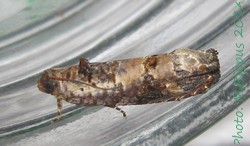
Dudua aprobola, the mango flower webworm or litchi leaf roller, is a moth of the family Tortricidae. The species was first described by Edward Meyrick in 1886. It is a pest on several economically important crops.

Biston suppressaria, the tea looper, is a moth of the family Geometridae. It is found in China, India, Myanmar, Nepal, and Sri Lanka.
Archips micaceana is a moth of the family Tortricidae. It is found in China, Hong Kong, southern Vietnam, Burma, and northern Thailand. It is a minor pest of many agricultural crops.

Homona coffearia, the tea tortrix or camellia tortrix, is a moth of the family Tortricidae. The species was first described by Nietner in 1861. It is widely distributed in the Oriental region.
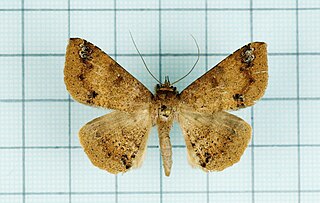
Ericeia inangulata, the sober tabby, is a moth in the family Erebidae. The species was first described by Achille Guenée in 1852. It is found in the Indo-Australian tropics of China, India, Sri Lanka, Myanmar, and the Marianas and Carolines, Fiji, Vanuatu, New Caledonia and Samoa.

Orgyia postica, the cocoa tussock moth or hevea tussock moth, is a species of moth of the subfamily Lymantriinae of the family Erebidae found in the Oriental tropics of India, Sri Lanka, Myanmar, Borneo, Java, New Guinea, and Taiwan. It was described by Francis Walker in 1855.
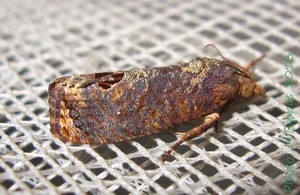
Cryptophlebia peltastica is a moth of the family Tortricidae. It is found throughout Africa from Ghana to South Africa and Eritrea, including islands of the Indian Ocean and is also known from Asia, the Pacific region (Guam) and from the Bahamas.

Cryptophlebia semilunana is a moth of the family Tortricidae. It is found in Africa, where it is known from Kenya, Uganda, Tanzania, South Africa, Madagascar, Réunion and Mauritius.
Indarbela quadrinotata, the bark-eating caterpillar, is a moth in the family Cossidae. It is found in India and Sri Lanka. It was described by Francis Walker in 1856.
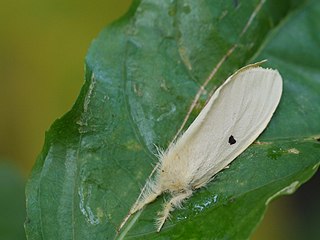
Euproctis lunata, the castor hairy caterpillar, is a moth of the family Erebidae. The species was first described by Francis Walker in 1855. It is found in India, Pakistan, Sri Lanka and Thailand.
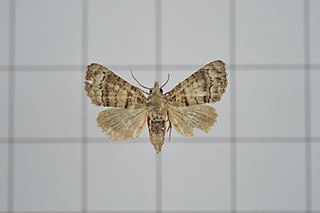
Chlumetia transversa, the mango shoot borer, is a moth of the family Euteliidae. The species was first described by Francis Walker in 1863. It is a widely distributed across Indo-Australian tropical countries far east to Solomon Islands.

Pammene critica, the redgram webber or leaf webber, is a moth of the family Tortricidae. The species was first described by Edward Meyrick in 1905. It is found in India and Sri Lanka.














